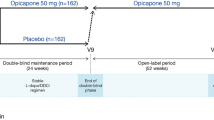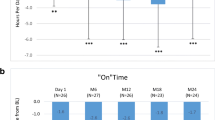Summary.
Objectives: To evaluate the tolerability, safety and efficacy of Stalevo® (carbidopa, levodopa and entacapone) in Parkinson’s disease (PD). Background: Levodopa provides the most effective symptom control for the treatment of Parkinson’s disease (PD). However, its long-term use is limited by the development of motor complications such as wearing-off. Catechol-O-methyltransferase (COMT) inhibitors such as entacapone extend the plasma half-life of levodopa and reduce ‘off’ time. Stalevo is a new levodopa product that combines carbidopa, levodopa and entacapone in one tablet. Clinical studies have not been reported with this compound. Design methods: An open-label, multi-center US trial evaluated 169 consecutive PD patients experiencing end-of-dose wearing-off, with (n = 39) and without (n = 130) mild dyskinesia. Patients were switched from immediate-release carbidopa/levodopa to Stalevo and were treated for four weeks. Assessments included tolerability measures, adverse events profile, the disease-specific quality of life instrument PDQ-39, UPDRS parts II, III, and question 39 and investigator and patient global clinical assessments. Results: 14 subjects (8%) discontinued treatment with Stalevo, of which 12 (7%) were due to adverse events. 11/130 (8.5%) subjects developed new onset dyskinesia and 17/39 (43.6%) of patients with existing dyskinesia reported a worsening in their dyskinesia. However, this was managed by a change in dose in 21.4% of patients and in another 10.7% dyskinesias resolved without any need for dose adjustment. Other side effects were infrequent and mild, the most common being nausea (12.4%) dizziness (6.5%) and somnolence (6.5%). Stalevo treatment resulted in significant improvements in PDQ-39 and UPDRS (II + III) scores (p < 0.001). Assessment of ‘off’ time demonstrated a reduction in off time in 32% of patients, compared with an increase in 7% of patients. Improvements were noted by both investigator (68.1%) and patient (68.6%) assessments. Conclusions: Switching PD patients experiencing wearing-off from carbidopa/levodopa therapy to Stalevo was safe, well tolerated and resulted in clinical improvement.
Similar content being viewed by others
Author information
Authors and Affiliations
Rights and permissions
About this article
Cite this article
Koller, W., Guarnieri, M., Hubble, J. et al. An open-label evaluation of the tolerability and safety of Stalevo® (carbidopa, levodopa and entacapone) in Parkinson’s disease patients experiencing wearing-off. J Neural Transm 112, 221–230 (2005). https://doi.org/10.1007/s00702-004-0184-1
Received:
Accepted:
Published:
Issue Date:
DOI: https://doi.org/10.1007/s00702-004-0184-1




